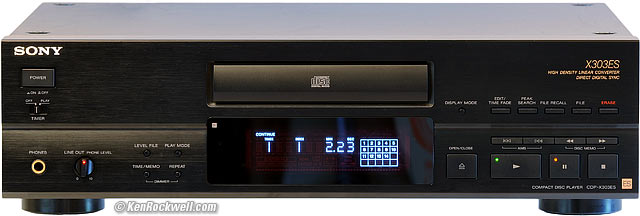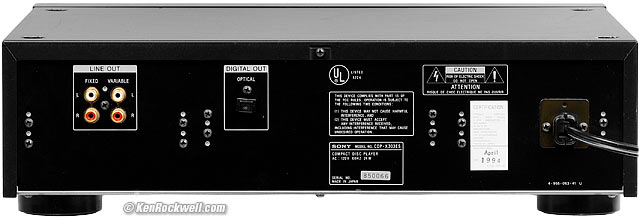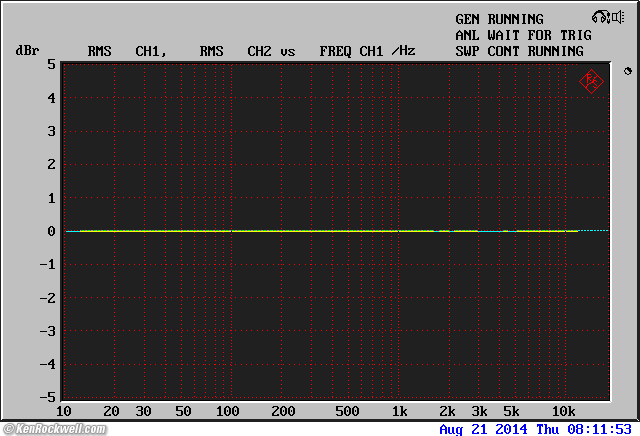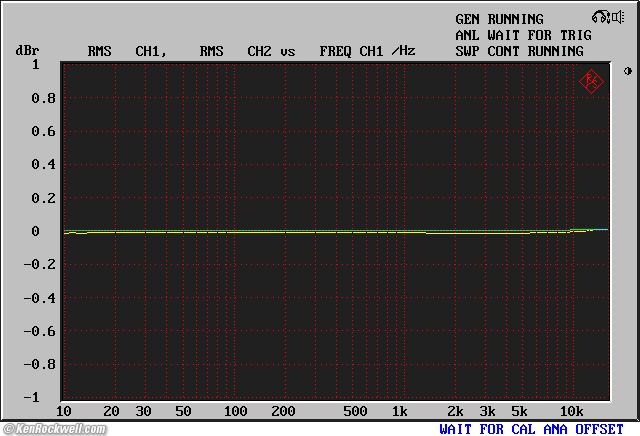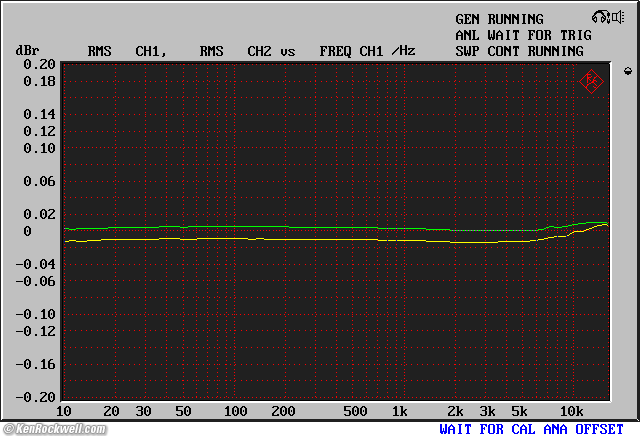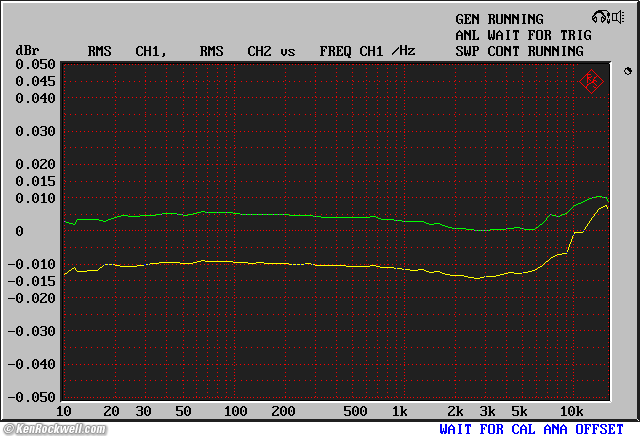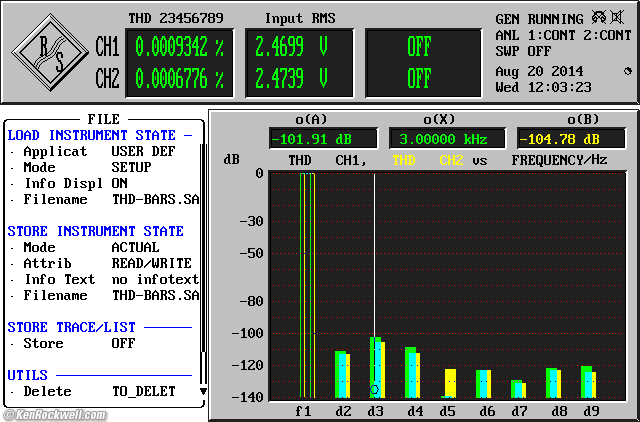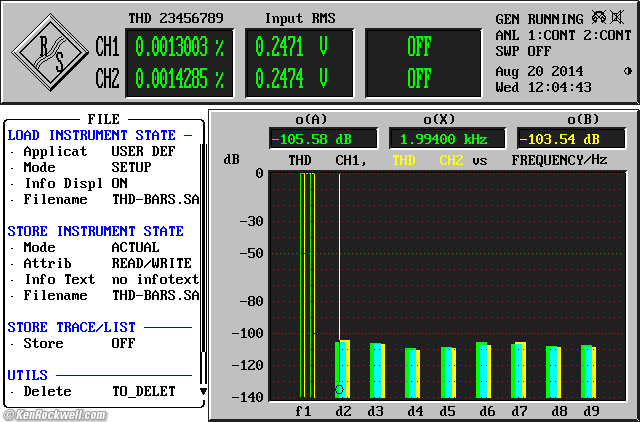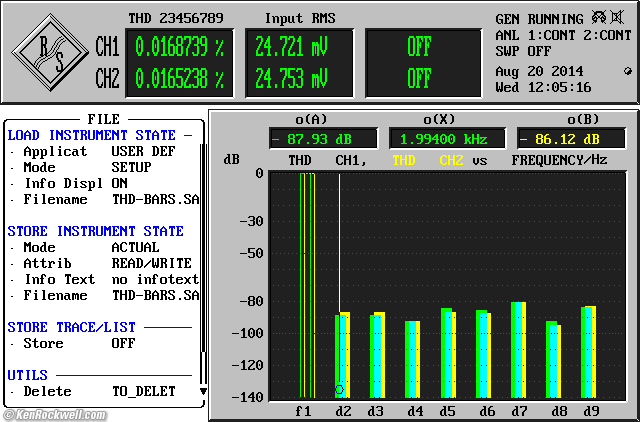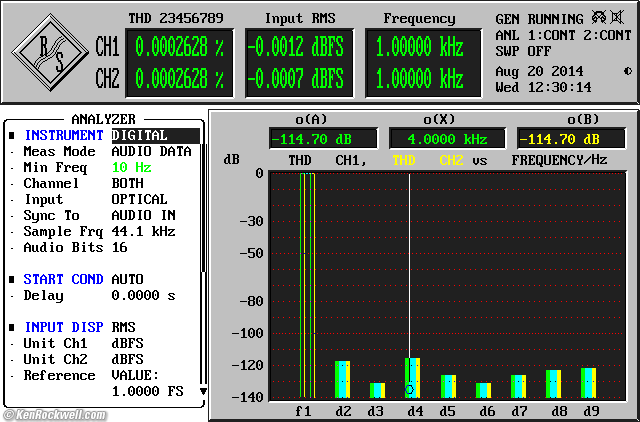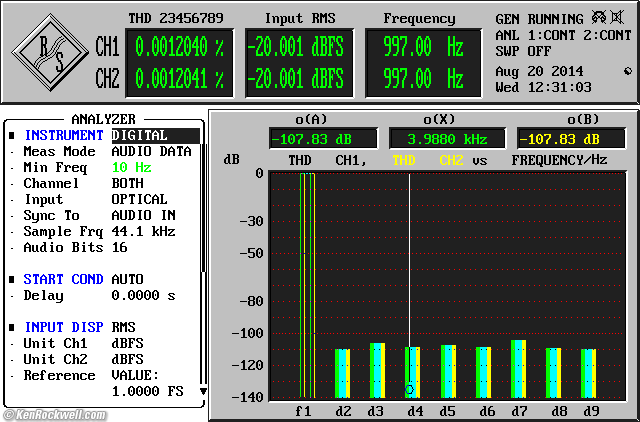Home Donate New Search Gallery Reviews How-To Books Links Workshops About Contact
Sony CDP-X303ES
Compact Disc Player (1993-1995)
© 2014 KenRockwell.com. All rights reserved.
Intro Specs Performance Measurements
Usage Compared Recommendations
Sony CDP-X303ES (about 24.5 pounds and about $250 used). bigger. I'd get it at this link directly to them at eBay (see How to Win at eBay).
Sony CDP-X303ES. bigger.
This free website's biggest source of support is when you use those or any of these links to approved sources when you get anything, regardless of the country in which you live — but I receive nothing for my efforts if you take the chance of buying elsewhere. I get no government hand-outs and run no pledge drives to support my research, so please always use any of these links to approved sources for the best prices, service and selection whenever you get anything. Thanks for helping me help you! Ken.
August 2014 All Reviews > Audio Reviews > Sony Audio Reviews
Introduction top
|
Adorama pays top dollar for your used gear. I use these stores. I can't vouch for ads below.
|
Intro Specs Performance Measurements
Usage Compared Recommendations
The Sony CDP-X303ES is such a great player that I bought two of them new in 1995 on closeout. It was second from the top of Sony's CD player line.
The CDP-X303ES comes from the peak era of CD player performance, when even normal people thought nothing of spending $500 or more for a fine CD player. This is a 25-pound masterpiece with a metal alloy CD tray, not a disposable plastic multiplayer.
I've been using my two CDP-X303ES for almost 20 years, and they continue to work flawlessly.
Timeline
1993
Introduced, along with the CDP-X202ES and CDP-X707ES.
1995
Discontinued and replaced by the CDP-XA3ES, with a looser frequency response specification of 2-20,000 Hz ±0.5 dB, and over ten pounds lighter at only 14 pounds, for a catalog price of $1,100, corrected for inflation ($700 at the time).
Because the CDP-X303ES was now the "old" model, I cleaned up and got each of mine for about $300 each on closeout, which is what they sell for used today.
Specifications top
Intro Specs Performance Measurements
Usage Compared Recommendations
Outputs
One fixed-level RCA stereo pair.
One variable-level RCA stereo pair controlled by a small knob near the headphone jack, or by the remote control.
One TOSLINK optical digital output.
One ¼" headphone controlled by a small knob, or by the remote control.
Frequency Response
2-20,000 Hz ± 0.3 dB.
(CDP-X707ES is exactly the same.)
SNR
Specified as 117 dBA in 1993, 118 dBA in 1994.
(CDP-X707ES is 1 dB better at 119 dBA.)
THD
Specified as 0.0018% in 993 and 0.0017% in 1994.
(CDP-X707ES is rated at 0.0015% THD.)
Size
125 x 430 x 375 millimeters (4.92 x 16.93 x 14.76 inches) HWD.
470 millimeters (18.5 inches) wide with wood panels.
Weight
Specified as 24-1/4 pounds in 1993 and 25 pounds in 1994 for USA.
10.6 kg (23 pounds 6 oz.) in Europe.
11.5 kg (25 pounds 6 oz.) in Canada.
(CDP-X707ES is packed with extra metal to bring it up to 36 pounds.)
Quality
Made in Japan.
Price (list, USA)
$1,200, including inflation in 2014 ($730 at the time).
(CDP-X707ES price was padded up to $3,300 including inflation in 2014! ($2,000 at the time.))
Performance top
Intro Specs Performance Measurements
Usage Compared Recommendations
It looks, feels and sounds great.
It's a big, solid player whose big alloy tray slides in and out silently, with a rubber gasket when closed.
The big pushbuttons click cleanly with very little push depth needed, and have no play. It's easy to find and hit the big buttons, compared to the wimply little dots on lesser players.
Operation is completely silent; you can't hear the disc spinning.
The headphone output has its own headphone amplifier, and feeds the jack through a current-limiting resistor.
Measurements top
Intro Specs Performance Measurements
Usage Compared Recommendations
Output levels Output Impedances Channel tracking
Frequency Response Noise, SNR & ENOB THD
Output spectra Square Wave Power Consumption
All these measurements are made in 2014 on a player that was built in 1994 playing the CBS CD-1 engineering test disc stamped in 1983.
The traces from the Rohde & Schwarz UPL laboratory analyzer are color coded for the Left Channel and for the Right Channel. When they don't lie on top of each other, it's due to channel imbalance.
As a testament to Sony's omnipresence, these curve plots were recorded on Sony floppy discs for transfer to this website for you to see here.
Unless otherwise noted, all are RMS at 1 kHz at 0 dBFS, loaded with 200 kΩ, from the fixed analog output.
Output Levels measurements top
Fixed Output Voltage
2.4750 V left, 2.4706 V right, 200 kΩ load.
This is 7.86 dBV, or 1.84 dB above 2 V.
Variable Output Voltage
2.4744 V left, 2.4703 V right, 200 kΩ load.
For 2.0 V output, set the pointer to the where the middle and vertical lines cross in the first E in LEVEL.
For 1.0 V output, set the pointer to the bottom of the U in OUT.
Headphone Output Voltage
7.67V RMS.
Output Source Impedances measurements top
Fixed Output Source Impedance
198 Ω at 1 kHz.
Variable Output Source Impedance
200.6 Ω at maximum level.
2.5 kΩ at 12 o'clock.
429Ω at 9 o'clock.
Headphone Output Source Impedance
94.5 Ω at 1 kHz.
Channel Tracking measurements top
Fixed Output Channel Balance
The left output is 0.0148 dB hotter than the right.
This is perfect.
Variable Output Channel Tracking
![]()
Right channel level versus left channel, vs. volume control setting. (positive means image moves to right.)
This is swell, the 10kΩ pot tracks reasonably well.
Frequency Response measurements top
Line output at 0 dBFS, 200 kΩ load. (CBS CD-1 track 11, R&S UPL.)
That's pretty flat. Let's greatly increase the vertical scale and see what happens:
Line output at 0 dBFS, 200 kΩ load. (CBS CD-1 track 11, R&S UPL.)
OK, let's increase it so far that most lab equipment can't measure it:
Line output at 0 dBFS, 200 kΩ load. (CBS CD-1 track 11, R&S UPL.)
Still flat. Let's magnify it to the unheard of precision of ±0.05 dB (5% or 1/20 of one dB):
Line output at 0 dBFS, 200 kΩ load. (CBS CD-1 track 11, R&S UPL.)
At +0.007 and - 0.003 dB, this is probably the flattest I've ever measured, flatter than the SCD-XA777ES, and flatter than almost all laboratory instruments.
The channels are balanced to within better than 0.015 dB, again much better than the SCD-XA777ES.
Noise, SNR and ENOB measurements top
Noise
-112.2 dBV A-weighted, playing digital zeros, which is quieter than the SCD-XA777ES.
-113.0 dBV A-weighted, paused.
SNR
Since 0 dBFS is +7.86 dBV, this is a 120.0 dB signal to noise ratio, the highest I've measured for 16-bit playback, 9 dB better than the SCD-XA777ES!
SNR
120 dB is 19.65 ENOB, or effective number of bits. Not bad; it's even better than the Benchmark DAC1 HDR!
THD: 0.0008% (-102 dB) measurements top
Analog output harmonic content, undithered 1kHz sine wave at 0 dBFS. (CBS CD-1 track 1, R&S UPL.)
Analog output harmonic content, undithered 1kHz sine wave at -20 dBFS. (CBS CD-1 track 18, R&S UPL.)
Analog output harmonic content, undithered 1kHz sine wave at -40 dBFS. (CBS CD-1 track 18, R&S UPL.)
Just for fun, let's see how much of this minimal distortion is from the CD player's DACs, and how much is inherent in the undithered 16-bit signal:
TOSLINK digital output harmonic content, undithered 1kHz sine wave at 0 dBFS. (CBS CD-1 track 1, R&S UPL.)
Aha! The digital signal does have less distortion than the CD player, at least at full scale. I was more interested in the source of rising distortion at lower levels:
TOSLINK digital output harmonic content -20 dBFS. (CBS CD-1 track 18, R&S UPL.)
Aha! The -20 dBFS distortion of the original digital source is about the same as what's coming out of the analog outputs.
I'm actually measuring the digital datastream itself in a laboratory, no DAC required. This is what comes out of the TOSLINK output.
Output Spectra measurements top
10kHz 11+12kHz IMD Square Wave
Let's see a zoomed FFT of a 10 kHz sine wave. Let's see what sort of spurs surround the carrier, which show us internal jitter:
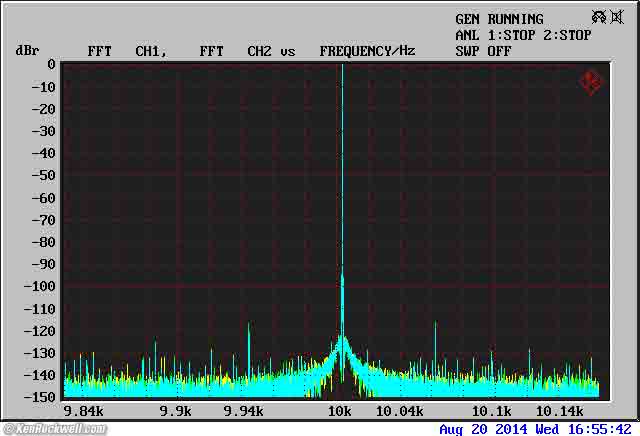
Zoomed spectrum of 10 kHz 0 dBFS sine wave. (CBS CD-1 track 9, R&S UPL.)
This is very good; I haven't seen any external DAC be able to beat this. The skirt doesn't start to spread until -120 dB!
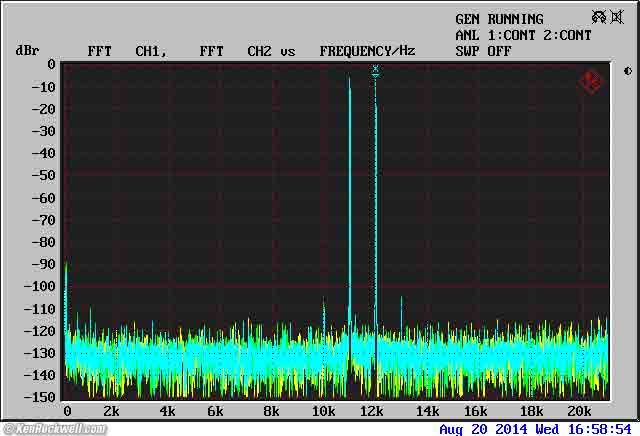
IMD spectrum at 11 kHz and 12 kHz 1:1. (CBS CD-1 track 13, index 2, R&S UPL.)
Ignore the DC component This is excellent!
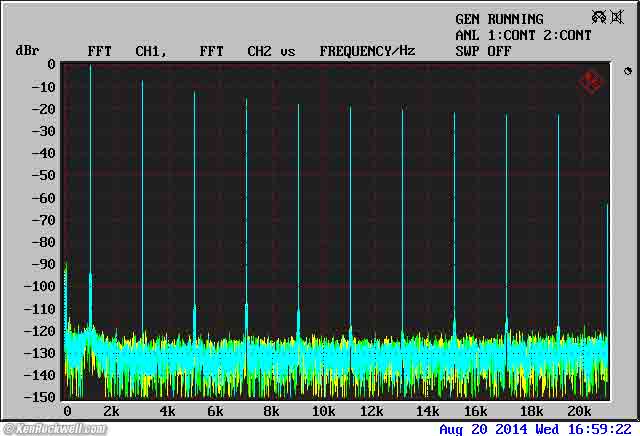
1,002.27 Hz 0 dBFS square wave. (CBS CD-1 track 16, R&S UPL.)
PERFECT!
A square wave contains odd-order harmonics only. Most outboard DACs can't handle this foolishly overloaded signal, and add even-order harmonics as the result of clipping or truncation.
In this case, the CD player is doing a superb job, and won't add any distortion to modern CDs recorded way over the limit. In this case, the test square wave is actually recorded at +3 dBFS RMS.
This is even better than the SCD-XA777ES.
Square Wave measurements top
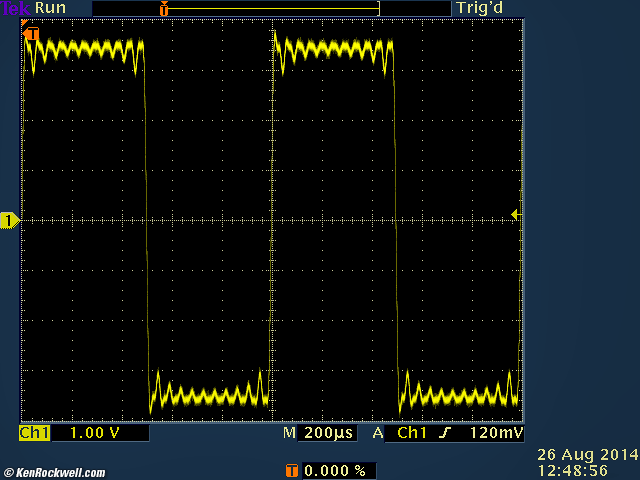
1,002.27 Hz 0 dBFS square wave. (CBS CD-1 track 16, TEK TDS3052.)
Band-limited square waves are supposed to have this ringing.
Actual Power Consumption measurements top
15.3 watts playing.
12.2 watts stopped.
0.0 watts turned off (completely disconnected).
Compared top
Intro Specs Performance Measurements
Usage Compared Recommendations
The CDP-X303ES was Sony's second most expensive CD player with a catalog price of $1,200 in today's dollars ($730 at the time ignoring inflation).
The only more expensive Sony player at the time was the CDP-X707ES, which packaged the X303ES guts in gold trim with balanced outputs and some weights inside to impress the innocent.
The X707ES stickered at $3,300 in today's dollars ($2,000 at the time, catalog price) to take rich suckers for a ride.
There was also an X505ES seen outside the USA, which again was the 303ES with some extra trim.
The less expensive X202 is also very good for less money.
I prefer a good CD player like this to an external DAC. For instance, this 20-year-old CD player measured today still has better frequency response, better overload handling and less noise and more dynamic range than a new Benchmark DAC1 HDR!
Usage top
Intro Specs Performance Measurements
Usage Compared Recommendations
Display Dimmer
Press the two buttons marked DIMMER to toggle among three different display brightnesses.
Variable Output
The variable output is the unbuffered output of a 10 kΩ linear taper pot.
It's 6 dB down at 12 o'clock, where it's output source impedance is maximum .
Load it with about 300Ω and it's about 20 dB down at 12 o'clock, with a lower output impedance.
Plug this output directly into a power amplifier and you don't even need a preamplifier.
The variable output is controlled by a motorized potentiometer from the remote control. The little red LED on the knob blinks as it's moving.
Indexes
One can access index points inside tracks, but only with the remote control.
Peak Search
For those CDs that aren't all recorded at 100%, press PEAK SEARCH to find and loop on the loudest part of a CD.
Custom Files and LEVEL FILE
This is a feature with which you can program the CDP-X303ES to recognize a disc next time it's inserted, and display text you've entered, recall the same variable level again, and whatever track programming you've added.
the CDP-X303ES can remember up to about 185 CDs, and will store this all for about a month if unplugged.
Of course some newer CD players display the names of discs without needing to be programed manually, and iPods can be programmed to make the levels the same from song to song if you set Sound Check in both iTunes and your iOS device.
Remote Control
Of course use the included remote for full access to remote volume control, programming and index access, but if all you have is the remote from any other Sony CD player, the basic commands should all work.
Recommendations top
Intro Specs Performance Measurements
Usage Compared Recommendations
I love mine. There are plenty of great CD players out there from which to choose, and the CDP-X303ES is a good one.
If you've found the time, effort and expense I put into creating and sharing this review helpful, this free website's biggest source of support is when you use these links, especially this link directly to them at eBay, when you get anything, regardless of the country in which you live.
Thanks!
Ken.
Help me help you top
I support my growing family through this website, as crazy as it might seem.
If you find this page as helpful as a book you might have had to buy or a workshop you may have had to take, feel free to help me continue helping everyone.
If you've gotten your gear through one of my links or helped otherwise, you're family. It's great people like you who allow me to keep adding to this site full-time. Thanks!
If you haven't helped yet, please do, and consider helping me with a gift of $5.00.
As this page is copyrighted and formally registered, it is unlawful to make copies, especially in the form of printouts for personal use. If you wish to make a printout for personal use, you are granted one-time permission only if you PayPal me $5.00 per printout or part thereof. Thank you!
Thanks for reading!
Mr. & Mrs. Ken Rockwell, Ryan and Katie.
Home Donate New Search Gallery Reviews How-To Books Links Workshops About Contact
